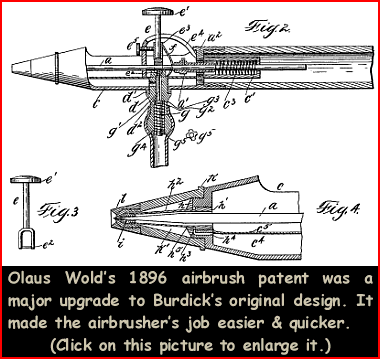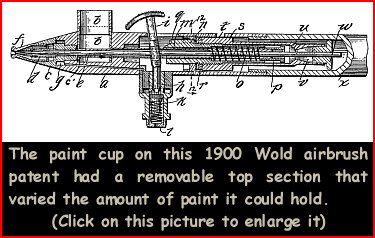 |
||
| AIRBRUSH HISTORY | ||
| "The Chicago Gang, Part 1" - Thayer & Chandler make Chicago the airbrush capital of the world. | ||
|
Chicago
hosted the 6 month long Columbian Exposition of 1893, the last and best
of the 1900's World's Fairs. Along with hamburgers, carbonated soda, and
the Ferris wheel, the 27 million visitors were also introduced to the
airbrush. The fair was an incredible opportunity for national and
international exposure and Liberty Walkup was there with his Airbrush
Manufacturing Company and he had great expectations for the fair.
Unfortunately he was upstaged by Thayer & Chandler, a Chicago mail
order
Thayer & Chandler continuously promoted and improved their airbrush.
In 1896, Olaus "O.C." Wold, a foreman at Thayer &
Chandler, filed a patent for an airbrush that used a replaceable nozzle
that protruded slightly from the front of the body. This eliminated the
paint buildup on the inside of the
In
1897, a patent is issued to Wold, also assigned to Thayer &
Chandler, for an airbrush that uses a trigger that slides fore and aft
to control both the air and paint. He claims ease of use and better
control at the finer range of the spray pattern. It also could be
disassembled without any tools, another nifty Wold idea. It was
produced and you can see the only known model by clicking
here. Wold would never totally Thayer & Chandler's airbrush line along with their crafts and china business continued to prosper into the mid 20th century when they dropped everything but airbrush manufacturing. They continued making the "Model A" until they closed their doors in 1999. The company was sold to Badger Airbrush of Franklin Park, Illinois, a suburb of, where else, Chicago. An interesting sidelight to the fair Is that it was within days of opening and 90% of the buildings were yet to be painted. Joe Binks, a maintenance supervisor at Marshall Fields Department Store in Chicago, had developed a paint spraying machine in 1890 to white wash the basements at Field's. It was put to work and every building was evenly covered with a dazzling whitewash and the "White City" was ready to open on Mayday, 1893. Binks later started the company that eventually became one of the premier maker of automotive and industrial spray equipment. | ||
| "PREVIOUS" "NEXT" | ||
Airbrush Home Airbrush Museum Airbrush History Airbrush Patents Rainbow Spray Airbrush Literature Hot Rod Airbrush Airbrush 101 Links Banner Links Photos Wig Bubbles Dedication Sťance Room |
||



 long path the paint has to travel; basic geometry, the shortest distance
between two points is a straight line.
long path the paint has to travel; basic geometry, the shortest distance
between two points is a straight line.